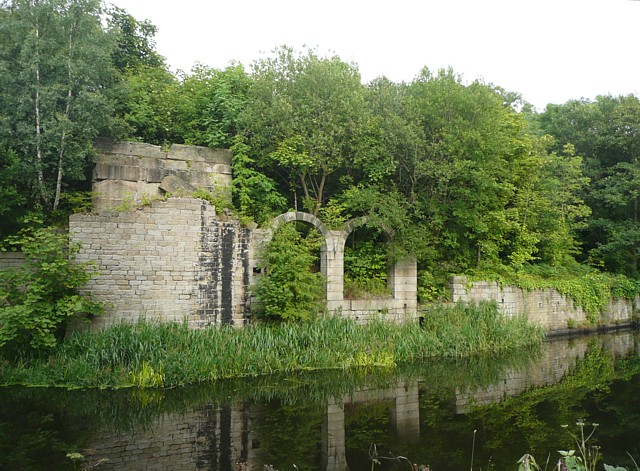My post today is about one of our walks that we embarked upon a week or so ago. It’s a walk we have done many times before where we set off by joining the canal towpath at the side of the Barge and Barrel in Elland. It was a very pleasant spring day and we all set off at a steady pace along the canal towpath going in the direction of Halifax.
It’s not long before you pass an old crumbled ruin that stands on the far side of the canal bank. It’s an attractive ruin with its two almost church like windows staring out at you from across the water. There was obviously a third window but that has lost its curved mantle. The ruin is now overgrown with ivy entwined around its stonework, and through those glassless windows you can see only trees.
Why does it stand so empty and forlorn, left abandoned and forgotten on the bank of the canal? What was it built for? Was it a house? A factory? Someone spend their hard earned time building and crafting those arch windows that now peer out emptily over the water. Why?
I would love to investigate it further but in order to do so, I would have to approach it from the road which is out of view but behind the ruin. If it was some sort of factory, then it seems to have been quite a substantial one as remnants of its size can be seen further down on the far left of this photo.
It intrigues me every time our walk takes us past it. Doing some sleuthing online has allowed me to glean some information about the ruin. It was a flour mill and was called Woodside Mill. As I had already concluded by the spread along the bank of the canal, it was quite a substantial building that stood between the canal and Halifax road. It actually stood 5 storeys high and in 1890 was the largest flour mill in Yorkshire. Here is a picture of it taken when it was in all its glory.

In this old photo its the very substantial building on the right. In the photo you can seen the river Calder snaking its way through the middle on the left of the canal. The mill was first owned by J.F. Milner (1890) and then Elland Flour Mills Limited from 1905. On Friday 4th March 1892 there was a dispute in the corn milling trade between the management and workers of J.F. Milner. Apparently a fire took place there on Monday, 22nd April 1907 which caused damage estimated at 2,000 to 3,000 pounds, quite a sum in those days.
In the photo above, you can also plainly see the cause of the demise of the canals as a method of transportation of goods. Yes, the railway steaming its way through the photo from left to right. Whether it was this that sealed the fate of this once huge building which had obviously been built alongside the canal for ease of transportation of its products remains to be seen.

Of course, during the summer months, the ruins are almost completely covered over with flora and the trees encroach almost entirely through those empty windows obliterating their stare across the canal.

How many feet used to walk behind those walls I wonder? How many people’s lives revolved around the Mill? How many bags of flour were produced and loaded onto those waiting barges, and what would be those workers thoughts if they could return and see it as it is now? As with any ruin I come across in my travels, I always wonder about the people who inhabited it, how they lived or worked and what life was like for them. Thanks to the Internet I’ve been able to find out at least a small amount of information about that intriguing ruin by the side of the canal.
TG

Those ruins really are fascinating. We don't have ruins of that age in our state however there are some abandoned gold mining towns we hope to visit this summer. It's a bit dangerous since we've had an early summer meaning the bears are out early. I enjoyed your blog today, thank you for sharing!
ReplyDeleteThank you for the pleasant walk along the canal and into history. Enjoyed your story.
ReplyDeleteIf you had said this was a monastery evicted by Henry VIII I would have believed you. Such a beautiful ruin and only rendered so 100+ years ago. Does everything in the UK age this wonderfully?
ReplyDelete